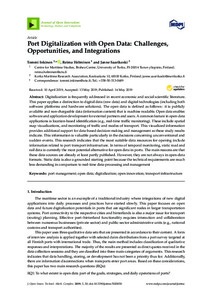Port Digitalization with Open Data: Challenges, Opportunities, and Integrations
Tommi Inkinen; Reima Helminen; Janne Saarikoski
https://urn.fi/URN:NBN:fi-fe2021042827310
Tiivistelmä
Digitalization is frequently addressed in recent
economic and social scientific literature. This paper applies a distinction to
digital data (raw data) and digital technologies (including both software
platforms and hardware solutions). The open data is defined as follows: it is
publicly available and non-chargeable
data (information content) that is machine readable. Open data enables software
and application development for external partners and users. A common feature in
open data applications is location-based identification (e.g. real-time traffic
monitoring). These include spatial map visualizations, monitoring of traffic,
and the modes of transport. This visualized information provides additional
support for data-based decision making and management as these study results
indicate. This information is valuable particularly in the decisions concerning
unconventional and sudden events. This research indicates that the most
suitable data resources, for opening, include information related to port
transport infrastructure. In terms of temporal monitoring, static road and rail
data is currently the most potential alternative for open data in ports. The
main reasons are that these data sources are already at least partly published.
However, they are not always in open data formats. Static data is also a
grounded starting point because the technical requirements are much less
demanding in comparison to real-time data processing and management.
Kokoelmat
- Rinnakkaistallenteet [27094]
